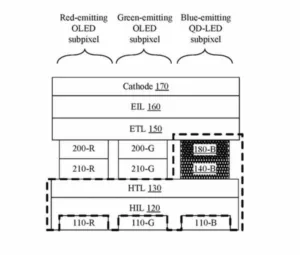With US patent application 20170221969, Apple describes a new hybrid display structure. The patent application is titled “Quantum dot LED and OLED integration for high efficiency displays” and describes very well what the company wants to achieve.
Apple OLED – QD LED Display Patent Application
In essence Apple is adding a quantum dot LED on the same backplane with AMOLED to create a more efficient display that should also be capable of producing better color imagery. The argument is that today’s OLED materials are not very efficient and it needs Phosphorescent OLED emitters to overcome the efficiency limits of conventional fluorescent OLEDs. However, while good green and red Phosphorescent OLED emitters already exist, blue emitters are not providing the color coordinates and life time required for displays.
As a solution, they suggest to add a micro LED with a top layer of quantum dots as the blue sub-pixel to two OLED sub-pixels. This would create a hybrid QD-LED / OLED RGB structure with improved color performance and better power efficiency. They are suggesting to use the same hole and electron injection layers for both sub pixels (OLED and LED). The patent application describes several different structures, all with the hybrid sub-pixel structure including other sub-pixel arrangements like RGBW, RBGYC or other layouts.
Analyst Comment
While this idea may help to bring phosphorescent OLEDs to the market quicker by eliminating the search for better blue emitters, it is far from clear if this is even a viable approach and can be manufactured effectively. Phosphorescent OLED displays are still some form of science fiction as are micro LED displays with quantum dots. Combining these two together on a backplane does not make this easier to manufacture. Using a combined electrode layer for both sub-pixels would make it easier in theory, but the LED still needs to be placed on the sub-pixel structure and covered with QD.
Given pixel densities above 300 ppi, one has to place LEDs with an accuracy of better than 0.003″ (roughly 80 micrometers), not an easy feat. The approach to manufacturability is certainly a process that will take some time to develop. However, Apple should have gathered some experience in this field and seems to think that this is solvable unless the patent is smoke screen to drive other companies to chase this idea. (NH)

